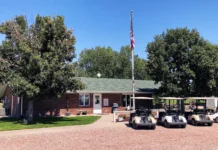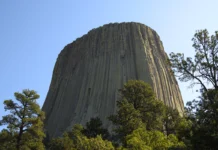| NEBRASKA |
The ram looked up from eating his grass and met my gaze. He had known me since I exited my car in the parking lot at the Cedar Canyon Wildlife Management Area in Scotts Bluff County.
| RESURGENCE
His herd was a 5-minute human walk away from me, but I took closer to 10 minutes, making sure not to startle the herd of about 15 big-horn sheep grazing at the base of the Cedar Canyon bluff. This herd is often spotted in the distance or climbing the edge of a bluff or mountain. This herd roams in and around the wildlife areas in southern Scotts Bluff County and nearby Banner County while another resides along the Pine Ridge area, a couple of hours north.
The bighorn sheep in North America consists of two species – Ovis canadensis and O. dalli. The herds in western Nebraska are Rocky Mountain Bighorn sheep (O. c. canadensis) and were introduced to the area in 2001 after another subspecies, the Badlands bighorn sheep, or Audubonís bighorn sheep, O.c. auduboni, became extinct. The badlands bighorn sheep were once native to the Great Plains of Nebraska, including the nearby Wildcat Hills, as well as in North Dakota, South Dakota, Montana, and Wyoming.

What happened to the Badlands bighorn sheep is still questioned. Accounts claim they were driven out of Nebraska in the late 1890s, while others say they were hunted to extinction in the early 1900s. Still, others say the subspecies survived until 1926. Some biologists claim it was never a subspecies at all but a variation of the Rocky Mountain bighorn. Regardless of what happened, the bighorn sheep were pushed out of the area due to habitat invasion by cattle and domestic sheep, disease spread by domestic livestock, respiratory disease, and unregulated hunting.
The Rocky Mountain bighorn sheep were successfully reintroduced in 1981 in the traditional bighorn range in a 500-acre enclosure at Fort Robinson State Park in northwest Nebraska. In March 2001, the Nebraska Game and Parks Commission reintroduced Rocky Mountain bighorns from Colorado to the Cedar Canyon WMA with a herd of 22 animals ñ twelve ewes, six lambs, and four rams. The herd is much larger today, with 51 ewes tracked by the University of Nebraska from 2018 to 2020. With further introductions from Colorado, Montana, and Alberta, several hundred sheep now call western Nebraska home.
| PROFIT OR PROTECTION?
Although the reintroduction has been successful and the number of bighorn sheep is still small, the Nebraska Game & Parks Commission began a harvesting program in 1999 known as the Bighorn Sheep Management Plan. It was designed to maintain and expand the Bighorn sheep population in Pine Ridge. According to the Nebraska Game and Parks Commission, the plan provides for hunting and viewing opportunities while keeping bighorn sheep numbers within the habitat’s carrying capacity at levels acceptable to most landowners.
A fee is charged each year for a permit auction and lottery in which one Nebraska resident can kill a full-curled ram. The winner can hunt the ram in Banner, Box Butte, Dawes, Morrill, Scotts Bluff, Sheridan, or Sioux counties, determined by Game and Parks, depending on ram availability.î

According to the 2022 brochure for the auction and donated funds from conservation organizations ìallowed Nebraska to re-establish bighorns in five areas of the Panhandle. Since the first hunting season in 1998, the Nebraska Game & Parks Commission has reported that 30 male rams were harvested in Nebraska, 11 by auction permit buyers and 19 by lottery permit winners.
The herd was estimated to be about 305 in 2022, having shrunk due to disease. This caused hunting to be prohibited in 2006, 2007, 2010, 2012, and 2013. Researchers, however, continue to track and monitor the herd for its health and to understand better what happens to the herds after several bighorn sheep succumb to disease, including recovery times and any habitat preference changes.
| KEEP YOUR DISTANCE
While bighorn sheep are more docile than the antelope and deer in western Nebraska and eastern Wyoming, they are always aware of their situation. They watched me cautiously. The biggest ram maintained eye contact, while the smaller rams occasionally noted me slowly walking toward them. They ate grass, then stared in my direction for a minute or two before returning to the grass. As I inched closer, it was soon apparent the entire herd knew I was there.
With his large, curved horns, the ram loomed over the herd. Through a zoom lens, it was evident this ram had been in battle before. The end of his horns was broken in a long-ago tussle. The horn appeared more blunt than short, but it was also evident that this ram was not to be messed with.
As a photographer, I shoot with my camera, not a gun, so I can share pictures with others so they, too, can go and see the majestic beauty of bighorn sheep in the Panhandle. Carefully, I attempted to get closer to the herd for a better, more detail-framed picture of the large animal watching me while protecting the herd.
I repeated a similar pattern of walking 25 feet, taking a photograph, and slowly moving forward. When I was about 75 yards away, the bighorn sheep decided the human had ventured close enough and began to move away. I took a few more pictures and decided to try again to get closer, but the sheep were smarter than me. They swiftly ran another 50 yards away from me. Humans cannot run as fast as bighorn sheep and cannot sprint up the side of bluffs or mountains; my luck had run out. With my camera at my side, I watched the herd continue to graze and stroll farther away until they disappeared into the distance.

The bluffs of the Cedar Canyon WMA and Hubbard’s Gap in Banner County provide the steep, rocky terrain bighorns use for escape and lambing. They can best be viewed in winter when rams and ewes gather for breeding.
Since it was still early in the day, there was still a chance to drive to Hubbard’s Gap to see if the other herd might also be there. Plumes of dust flew out from behind the wheels. The road is coarse dirt, making it easier for lighter cars to fishtail if they go too fast. The road here is surrounded by bluffs, making it an excellent spot for the bighorn sheep to graze in before running back up the side of whatever landmass they desire.
After slowing down to take in the view, ten bighorn sheep stroll out of the tall prairie grass and stand in the middle of the dusty road, blocking further movement. I unroll the window and hoist myself partway out. The bighorn sheep stare at me. I am less than 50 feet away. They permit me to take several photographs before they walk, then run up into the nearby field. Some sit down, blending into the scenery. Others stop, turn back for a quick look, then trot away into the distance toward Sheep Mountain, located on private property.

If you visit southern Scotts Bluff to photograph the Big Horn sheep, you should bring, at minimum, a 300mm lens, though a 500mm lens would be a better choice. Bighorn sheep are skittish around humans, rarely letting any get close to them. They are sensitive to human disturbance, including loud noises, which can place undue stress on the animals.
It is not advisable to approach the animals to pet or take selfies with them. Males can weigh more than 300 pounds, and their muscular bodies can severely damage a human.
| VIEWING BIGHORN IN WESTERN NEBRASKA
To reach the Cedar Canyon Wildlife Management Area from Gering, travel South on Highway 71 and turn right onto Carter Canyon Road.
Travel West on Carter Canyon Road for 6.1 miles, then turn left onto County Road 17.
Follow the dirt road for approximately two miles until reaching a fork in the road. Stay to the right and you will see a sign for Cedar Canyon a few moments later.
The parking area is two-tenths of a mile down a windy road.
To reach the Hubbard’s Gap area from Gering, travel East on Highway 92 for 21 miles and turn South onto County Road 34 at McGrew to County Road 67.
Both county roads are labeled as Hubbard’s Gap Road. Looking southeast at the intersection of County Road 67 and County Road 42, Sheep Mountain can be seen. Chimney Rock National Historic Site can be seen to the northeast.
While in these locations, it is highly suggested to wear a reflective safety vest or bright clothing, as hunting is allowed in the area.
| QUICK FACTS
- In 1981 12 bighorns were released into a 500-acre enclosure at Fort Robinson State Park near Crawford.
- In 2001 22 bighorns from Colorado were released in Cedar Canyon Wildlife Management Area in the Wildcat Hills.
- In 2005 49 bighorns from Montana were released on Bighorn WMA in Pine Ridge near Crawford.
- In 2007 51 bighorns from Montana were released on private land in the eastern Wildcat Hills near McGrew.
- In 2012 41 bighorns from Alberta were released at Sowbelly Canyon northeast of Harrison.
- In 2014 26 bighorns moved from the Wildcat Hills to Pine Ridge.
Source: Nebraska Game & Parks Commission
| CREDITS
Story by: Irene North
Photography by: Hawk Buckman & Irene North































